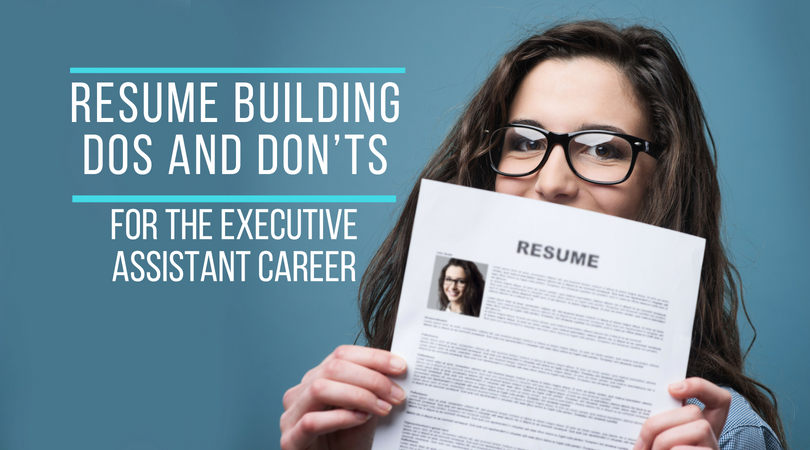Resume Building Do’s and Don’ts
For the Executive Assistant Career
The career of an executive assistant can be extremely demanding, yet incredibly fulfilling. Assistants run the lives of the world’s most successful individuals. Patrick Healy, President of New York Celebrity Assistants says, “With the support of a good assistant, the principals can do the hard work and make effective change in the world. They need a trusted confidant to take over the logistics of their lives, so they are free to ponder the bigger questions and take action. The passion also lies in being in charge – as we all know, the assistants run the world!”
But how does one get into the assistant career? Or, for those already in the role, how does one make a move to a new position or company? The answer is dust off the ole resume.
Building a resume can be a daunting task that we often only update when actively job searching. A resume should be updated regularly, even if you are not seeking a new job, and serve as your career marketing document. To make for a seamless resume reboot, we’ve put together a do’s and don’ts list tailored to the executive assistant role:
Contact Section
Do include name, address, email address(es), phone number, website (if applicable), LinkedIn URL
Don’t forget to make your name stand out. Your name should appear in large bold letters. Leave space to create an engaging header. You can find numerous free templates online. Etsy is a great resource when it comes to templates. The best route is to use a template or to build your resume in Adobe InDesign.
Don’t build your resume using Microsoft Stylesheets. Recruiters tend to discourage using templates since many ATS (applicant tracking systems) aren’t able to read/process formatted files. Also, sometimes recruiters will need to reformat and edit resumes, and it’s difficult to do that within a template.
Do be creative with your resume design, without going overboard and making it distracting. Aim for eye-catching but not obnoxious.
Objective Section
Do keep this short. According to the Harvard Business Review, it should be a short elevator pitch.
Do use it if you can ensure it’s highlighting your skills and abilities to enhance your resume.
Don’t use it if it’ll push your resume over one page.
Skills Section
Don’t use assumed and required skills in your skills section. For example, Microsoft Word is a software that’s assumed you are familiar with. Only use these terms if they are included in the job description.
Do include skills such as social media, for example, because it expresses your proficiency with technology and ability to assist with personal branding. Include any project management or calendaring programs you use.
Achievements Section
Don’t skip your accomplishments! If you have brag-worthy feats, add an “Achievement” section where you’ll highlight major projects, awards, and volunteer work. Did you win Admin of the Year in your company? Say so here.
Education Section
Don’t list any high school accomplishments or jobs, unless high school is your highest level of education.
Do include your college GPA (if it was above a 3.0), college majors and minors, college clubs, college Honors Societies, college Athletics, college Class Rank in your education section.
Professional Experience Section
Do quantify your work. You want the professional section of your resume to answer questions that could be asked in an interview before they are asked. Here are a few examples:
Weak: ‘Managed a team of admins.’
Strong: ‘Managed a team of six admins in three departments.’
Weak: ‘Organized events for c-suite executives.’
Strong: ‘Orchestrated company-wide events for c-suite executives across four cities.’
Do follow the “Rule of Seven”. Use relevant words such as “managed” “lead” “partner” “strategic” in your resume at least seven times. According to RockStarCV, using the marketing Bible’s “Rule of Seven” will ensure the reader of your resume walks away remembering why they should hire you.
Don’t include everything. Purge old jobs from before you were an EA. If you’ve never been an EA, keep just the relevant jobs that will highlight the skills you will need in your EA career.
Do incorporate keywords from the job description. Your resume will most likely be scanned to the percentage of keywords that overlap from the company job description. Bulk up your resume’s language to reflect the job description language. There are free websites you can use that will scan your document and tell you how compatible it is with the job description you’ve inputted.
Don’t forget power verbs. These include words such as collaborated, implemented, improved, lead, managed, and more.
Last but not least…
Do beef up your LinkedIn profile. Part of successfully mastering your resume is ensuring your LinkedIn profile matches. Check out executive assistant LinkedIn tips, here.
Your resume is a reflection of the future position you want to have, not an autobiography of your past. Use the job description of the job you wish to have to bulk out the vocabulary on your resume. Your resume is ultimately serving as a marketing document. Make sure the theme fits your personal style.
Once you have your resume built out, don’t be afraid to ask for help. Round up the troops for edits! With these simple steps in mind, you’re well on your way to writing a compelling resume. You already have the skills for the job, now it’s time to exemplify it.
Looking to further expand your EA skill set? Join executive assistants in your area at an Executive Leadership Support Forum near you. Learn from expert instructors and EA peers through the two-day MBA style business course.



